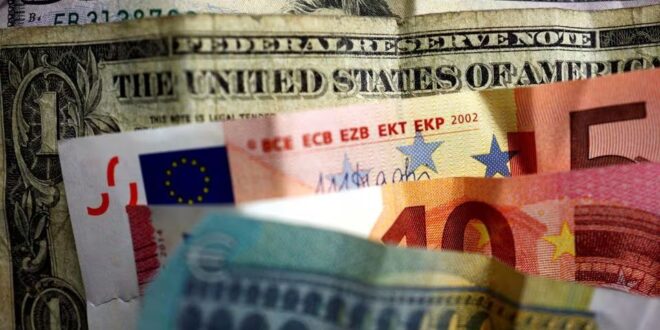WHAT looked from a distance like an unscalable debt ‘maturity wall’ for ‘junk’-rated US companies next year might be easier to jump after all.
With borrowing costs elevated by the Federal Reserve’s (Fed) most aggressive interest rate-hiking cycle in 40 years and expected to stay high, there are fears that firms with the lowest credit ratings will struggle to refinance, potentially spreading a wave of defaults and financial distress over the wider economy.
Some of the numbers are certainly eye-catching.
Nearly US$1.5 trillion of high-yield debt, including loans, is maturing globally through the end of 2026, of which US$882bil is US debt, according to S&P Global.
Of that, US$338bil is in bonds: US$53.8bil maturing this year, US$125.5bil next year, and US$158.6bil in 2026.
These are large amounts of debt for companies having to refinance at potentially double the original rate. But early indications show they are managing to do just that.
And there are reasons to believe they can successfully navigate the path ahead too: the economy is showing no sign of rolling over, attractive yields are bringing lenders back, while cooling inflation keeps rate cuts on the table.
It’s a favourable set of conditions for junk-rated firms, which tend to begin rolling over their debt earlier than cash-rich investment-grade firms, around 12 months before maturity.
S&P Global research shows non-financial firms globally last year reduced 2024 maturities by 44%, lowered 2025 maturities by 27%, and even started trimming 2026 maturities by 6%.
Looking solely at corporate bonds, excluding loans, the 2024 maturity wall was reduced by 13% last year and the 2025 wall was lowered by 6%. This has continued in the first two months of this year.“In our view, the maturity wall is not a significant risk over the next 12 months,” said Amanda Lynam, head of macro credit research at BlackRock.
Lynam also notes two other encouraging signals for the high-yield market: Default rates may be plateauing and there is an increased willingness to lend to the lowest quality borrowers.
Default rates on junk-rated corporate bonds, those with a BB- credit rating or lower, look to have levelled off in recent months around 4%.
That in itself is a pretty low level historically, certainly relative to previous episodes of wider economic or financial stress when they reached 8% at a minimum.
Default rates may well rise further but not that far, barring an unforeseen shock. Analysts at S&P Global expect the US trailing-12-month “junk” corporate default rate to reach 4.75% by the end of this year.
After a near-uninterrupted, two-year hiatus since the Fed began its policy tightening cycle in March 2022, CCC-rated US borrowers are issuing debt again.
They feel confident coming back to the market, but lenders are also prepared to lend to them again.
The resilience of the junk bond market – yield spreads over Treasuries are the narrowest in two years – indicates that the economy’s glide path to a “soft landing” or even “no landing” has perhaps been hiding in plain sight all along.
While the deeply inverted yield curve, soured consumer confidence and other time-honoured recession markers have long flagged a pending downturn, the high-yield bond market has been flashing completely opposite signals.
Junk bonds are often among the first assets investors dump when rising interest rates start to bare their teeth, credit conditions become too tight, and the good times on Wall Street and Main Street come to a halt. Sometimes a crashing halt.
But if “higher for longer” borrowing costs are a headwind for junk, “stronger for longer” economic growth is an even more powerful tailwind.
“We view a stronger economy as more favourable for credit quality as it should help support issuers’ revenue and growth, which can help offset higher borrowing costs,” said Evan Gunter, director, Credit Research & Insights, at S&P Global Ratings.
Junk-rated companies don’t have the cash buffers to see them through the bad times that investment-grade companies do, so they are more reliant on good old-fashioned growth to ensure they can meet their borrowing needs.
To be sure, these needs will become more pressing in a few years’ time when post-pandemic borrowing starts to mature. According to S&P Global, the global high-yield maturity wall in 2028 will be US$1 trillion, higher than the investment-grade wall.
That may scare the horses. But there’s a long way to go before then.
As Michael C. Eisenband, global co-leader of corporate finance & restructuring at FTI Consulting, points out, every bout of maturity wall panic in markets or the media in the past 15 years has passed off without incident.
Super-loose Fed policy and trillions of dollars of quantitative easing might have helped, of course, but he has a point.
“Much like other feared apparitions such as the Loch Ness monster and Sasquatch, the maturity wall is visible at great distance but never up close,” he wrote last month. — Reuters
Jamie McGeever is a columnist for Reuters. The views expressed here are the writer’s own.
 BeritaKini.biz Berita Viral Terkini di Malaysia
BeritaKini.biz Berita Viral Terkini di Malaysia





